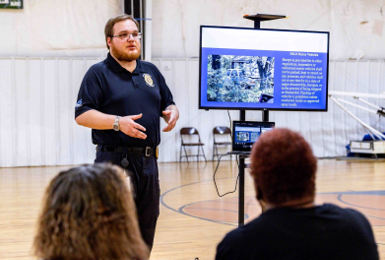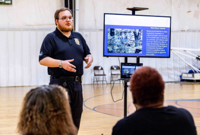The City of Greer is flipping the script on code enforcement by leading with conversations instead of citations. The shift from penalty-based enforcement to education-focused encounters could reshape how residents interact with their local government and ultimately help our community grow stronger together.
Traditional code enforcement is a straightforward process. An officer observes a violation, sends a letter with legal language, and, if nothing changes by the deadline, issues a fine or begins a process called abatement to correct the problem. This process may be efficient, but it can create unneeded tension, confusion, and distrust.
Issues such as overgrown grass, piles of debris, or an inoperable vehicle can quickly escalate into fines, liens, or even court cases. That escalation can feel less like protection and more like punishment for residents who don’t understand what the city is asking them to do and why it matters. Property problems often resurface in cases that lack understanding, and code enforcement officers end up going back to the same properties to issue the same or similar notices. As a result, relationships between residents and the city can become strained instead of growing stronger.
The purpose of code enforcement has never been to punish. The goal is to protect the health, safety, and welfare of both the city and its residents. When the process feels oppositional, that purpose gets lost. Education can bring the end goal back into focus for everyone involved.
When city staff determined the old rinse-and-repeat cycle of code enforcement was not sustainable, the team committed to making some changes in how it approaches violations. The newly renamed Community Standards and Compliance Division has embraced a philosophy of outreach with the goal of reframing enforcement into a collaborative community effort. Compliance at its core is all about improving the safety, health, and welfare of everyone who calls Greer home, and that takes teamwork to achieve.
Our team is taking intentional steps to build greater understanding around city codes. Now, when officers observe violations, the process looks very different than in the past. The first step of engagement is to knock on doors with the intention of starting conversations and avoiding confrontations. Officers now take the time to explain what their job is and why codes matter before they outline concerns about a specific property. In many instances, the positive initial contact results in the homeowner correcting the violation and the officer closing the case.
Our team hopes to build trust within the community by taking intentional steps to increase connection through clear communication. Establishing a higher level of understanding could lead to new partnerships between homeowners and the city working together to accomplish shared goals. Fewer code violations will end in fines or court cases, and the old repetitive cycle of violation-enforcement-punishment will evolve into long-term compliance through collaboration.
The City of Greer is putting the new education and outreach philosophy into practice with in-person neighborhood engagement events. Our team has already hosted three Code Enforcement-centered Community Engagement Meetings this year. Dozens of residents, City Council members, and staff have attended. The gatherings provide an opportunity for the team to lay out revised processes and expectations in plain language. Residents can ask questions about codes and learn the “ins and outs” directly from people whose job is to uphold community standards.
Along with hosting engagement meetings, the team has created a “Notice of Concern” form that explains violations in a non-threatening way. The new notice includes clear language and contact information and encourages residents to reach out with questions or to ask for help.
Another important element of the new strategy involves intentionally organized volunteer initiatives. Our team is looking to create opportunities to work with churches, civic groups, and neighborhood leaders to provide additional resources to residents in need. Enlisting volunteers to assist with tasks such as grass-cutting and debris removal will reinforce the idea that keeping our community clean and safe is a team effort that has far-reaching support.
The Community Standards & Compliance team must also collaborate internally to be effective. Codes officers work closely with other departments such as Police, Fire, and Public Services to resolve compliance issues. For example, an abandoned house could raise concerns about safety, sanitation, and potential crime. When residents witness city departments working together to resolve issues, they may also see how a unified effort could lead to a safer community.
Online tools will play a growing role in our new strategy. Soon, residents will be able to quickly access resources, contact information, and education on local codes. Through our website, people will be able to better understand a Notice of Concern and access the International Property Maintenance code to learn more. These tools will empower residents to take action on their own and know they have the support of their local government if they need it.
Our team has ambitious goals. We want to expand our engagement efforts by hosting more meetings in more neighborhoods across the city. We want to increase accessibility by providing online resources to assist residents with common issues. We want to strengthen partnerships by building a volunteer corps to support cleanup efforts and help the underserved. We intend to use community feedback to better understand the needs in our city and track compliance rates to measure the effectiveness of our new strategy.
The real measure of success will be in the number of conversations that lead to solutions. When our team avoids escalation and resolves a concern through communication and collaboration, it’s a sign the new system is working as we intended. When residents know the city will support them in resolving issues instead of automatically punishing them, when compliance becomes less of a burden and more of a shared responsibility, when the city becomes a resource instead of an obstacle, we will have succeeded in flipping the script.
Code enforcement is all about upholding the standards a city sets for itself and ultimately increasing community pride, safety, and the quality of life. By replacing threatening letters with outreach and empowerment, Greer is showing that enforcement done differently leads to more than just compliance. It builds trust. It builds relationships. It builds stronger neighborhoods. Above all, it shows we are “Building Greer Together.”










